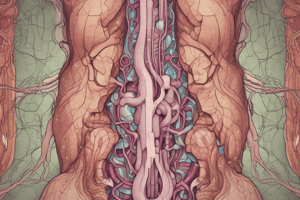Podcast
Questions and Answers
What is the primary function of the renal corpuscle in a nephron?
What is the primary function of the renal corpuscle in a nephron?
- Storing urine
- Regulating electrolyte balance
- Reabsorbing essential nutrients
- Filtering waste products and excess fluids from the blood (correct)
What is the role of the renal tubule in a nephron?
What is the role of the renal tubule in a nephron?
- Filtering waste products and excess fluids from the blood
- Reabsorbing essential nutrients and regulating electrolyte balance (correct)
- Storing urine
- Propelling urine downward through the ureters
How many cups of urine can a typical healthy adult bladder store?
How many cups of urine can a typical healthy adult bladder store?
- 2 cups (correct)
- 1 cup
- 3 cups
- 5 cups
What is the purpose of the rhythmic contraction of the ureters?
What is the purpose of the rhythmic contraction of the ureters?
What is the location of the kidneys in the abdominal cavity?
What is the location of the kidneys in the abdominal cavity?
What is the function of the urinary system?
What is the function of the urinary system?
What is the shape of the bladder?
What is the shape of the bladder?
What is the purpose of the nephrons in the kidneys?
What is the purpose of the nephrons in the kidneys?
What is the function of the ligaments attached to the bladder?
What is the function of the ligaments attached to the bladder?
How long can a typical healthy adult bladder store urine?
How long can a typical healthy adult bladder store urine?
Flashcards are hidden until you start studying
Study Notes
Renal Physiology
The urinary system is responsible for filtering blood, removing waste products, and maintaining the body's fluid balance. The renal physiology of this system involves several key components, including the kidneys, ureters, bladder, and urethra.
Kidneys
The kidneys are a pair of bean-shaped organs located in the back of the abdominal cavity, high in the abdominal cavity against the vertebral column between the levels of the 12th thoracic and third lumbar vertebrae. They filter blood to remove waste products and maintain the body's electrolyte balance. Each kidney contains millions of nephrons, which are the functional units of the kidney. Nephrons consist of a renal corpuscle and a renal tubule. The renal corpuscle filters waste products and excess fluids from the blood, while the renal tubule reabsorbs essential nutrients and regulates electrolyte balance.
Ureters
The ureters are a pair of narrow tubes that carry urine from the kidneys to the bladder. They have a rhythmic contraction that propels urine downward, preventing urine from stagnating and causing kidney infections.
Bladder
The bladder is a triangle-shaped organ located in the lower belly. It is held in place by ligaments attached to other organs and the pelvic bones. The bladder's walls expand and contract to store urine and empty it through the urethra. The typical healthy adult bladder can store up to 2 cups of urine for 2 to 5 hours.
Urethra
The urethra is a tube that allows urine to pass outside the body. It is controlled by the brain, which signals the bladder muscles to tighten and the sphincter muscles to relax, allowing urine to exit the bladder through the urethra.
In summary, the renal physiology of the urinary system involves the kidneys filtering blood, ureters transporting urine to the bladder, the bladder storing and emptying urine, and the urethra allowing urine to exit the body. This system works together to maintain the body's fluid balance and remove waste products.
Studying That Suits You
Use AI to generate personalized quizzes and flashcards to suit your learning preferences.


